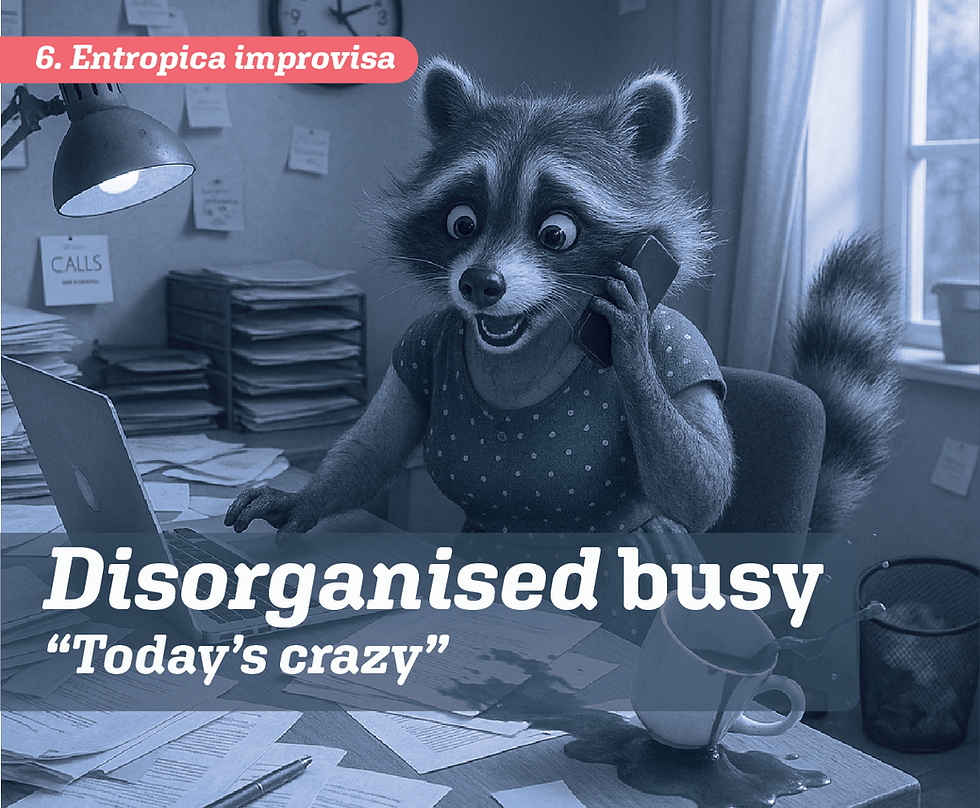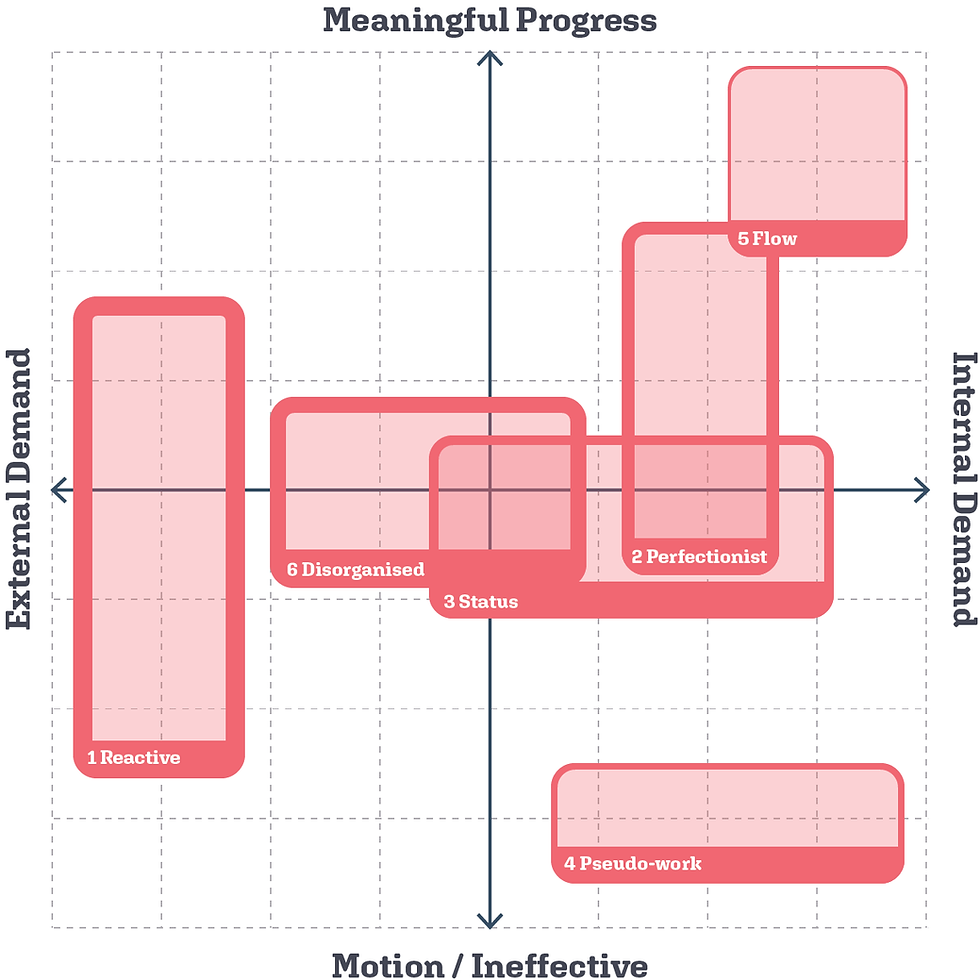Six Types of Busy And How To Escape Them
- Bruce Stanley

- Sep 25
- 5 min read
Updated: Sep 26
Why busyness isn’t the same as a good life and the hidden costs of busy.
Have you noticed, of the ways people answer the question, 'how are you?', 'busy' has to be at the top of the list. The question used to get you a, 'fine thanks' but now it gets you a, 'Let me catalogue my chaos', or, 'My to-do list is so long I added make shorter to-do list to it. Then ticked it for the quick win.'
Busy, can mean different things, though. Busy, you? can be a ritual display to avoid follow-up questions. It can be a way to signal importance (without actually having to prove it). Sometimes busy can mean: scared to start the real thing; I can find time to descale the kettle. I never find time to scale the project.

Whilst I was supposed to be scaling my own project, I came up with this taxonomy of busy types. You probably recognise your friends in these species – and recognising yourself is also the point.
Here's my spotters, field-guide to busy

1: Reactive Busy / Notificata obligata
The classic yes, of course, affiliator type – always saying yes, always answering the ping. A day shaped more by incoming requests than any reflective strategy. Typical tell: their diary looks like they've graffitied it with felt-tips. Risk: they end up living a patchwork life shaped from everyone else’s agendas. They perceive they're needed, but there is a high risk of burnout.
Day Crafting interventions
Run a polite decline experiment: for 24 hours, say no to anything new that arrives. Note the fallout (spoiler: the world keeps turning).
Design a buffer-time Blueprint – one protected block where your attention isn’t up for grabs.
At day’s review, ask: How much of today did I actually choose? Then sharpen tomorrow’s boundaries accordingly.

2: Perfectionist Busy / Exactrix interminata
Polishing, refining, improving – then polishing again. This type is fuelled by the belief that no one else will do it properly, so they take it all on and keep sanding the same corner. Typical tell: they're still just tweaking when everyone else has gone home. Risk: progress stalls, joy evaporates and life shrinks into an endless loop of unfinished masterpieces.
Day Crafting interventions
Start each task by naming the good-enough finish line. Ship at 90%.
Run a one-hour carve-and-stop experiment: no matter how rough, stop at the hour. Notice what really matters. More clock-time is for you.
In review, ask: Was more polish worth the cost of energy and time?

3: Status Busy / Ostentator calendarius
The diary peacock. Status is signalled not by plumage but by back-to-backs and breathless, slammed replies. Typical tell: they talk about workload before anything else, sometimes before hello. Risk: busyness becomes identity; underneath the feathers, there’s not always much else going on.
Day Crafting interventions
Banish the word busy (when you really mean important) for a week; replace it with focused on [X]. See how that makes you feel.
Run a calendar detox: cancel one recurring meeting and measure the impact.
Redefine your identity and base your worth on being time-rich and what you can do with it. Find your alternative answer to busy.

4: Pseudo-work Busy / Simulatio rotans
All about vanity metrics, it looks like motion, feels like work, but goes nowhere. Lists reorganised, inbox cleared, desk immaculate. Typical tell: they’ve been so productive but haven’t touched the task that actually matters. Risk: time gets consumed by the performance of progress, while the meaningful work gathers dust.
Day Crafting interventions
Begin the day with a needle-mover: one small step on the scary task before any cosmetic work.
Use the scruffy sentence rule: write the first rough line to break inertia.
In review, ask: Did I spend today on progress or performance? (And get a job (side hustle) that engages your purpose. It's how I started Day Crafting.)

5: Flow Busy / Opifex fluens
The sweet spot: absorbed, playful, time disappears, output flows. Typical tell: they forget meals and look up hours later, feeling oddly refreshed. Risk: even flow has a shadow – possible neglect of maintenance, relationships, or rest when you vanish too deeply into the groove.
Day Crafting interventions
Protect flow with a protected environment: silence pings, clear space, dive in.
Experiment with time-capping: stop mid-flow and see if returning strengthens or weakens the groove.
In review, ask: Did this flow session enrich my day, or cannibalise the rest of it?

6: Chaotic Busy / Entropica improvisa
The beautiful mess. Days are improvised, double-booked, and full of accidental adventures (many, in this category, are very attached to the drama, especially if it's paired with the first category. Typical tell: they arrive late, flustered, and apologising to the wrong person. Risk: opportunities get lost in the noise, relationships are strained and energy is spent on rework instead of craftwork.
Day Crafting interventions
Start with a five-minute cut-list: work out your real capacity for the day before diving in.
Build one buffer slot each week (or daily) where nothing is planned. Use it to absorb chaos instead of spreading it.
In review, ask: How much of my stress was self-inflicted by poor planning?
I mapped the types of busy on this diagram to show where the demand is coming from vs the output.

The good-life evidence points towards being time-rich
Culture prizes money and productivity first, yet the evidence for wellbeing and flourishing points to something different – time affluence. When we feel we have plenty of time, our Quality of Inner Life and our Quality of Actions and Behaviours both rise; when we feel time-poor, stress and distraction climb instead.
This isn’t a small adjustment but a major identity shift. To stop introducing yourself as busy and instead as time-rich (or whatever the less pompous alternative is) means rewiring what you value and how you measure enough. Ashley Whillans’ excellent book Time Smart pulls together the research if you want to see the wider evidence base.
Finally. When not to answer: I'm busy
Sometimes, I think, busy may be the new rude: telling someone you’re too busy is basically saying, I ranked you lower than whatever nonsense I was already doing. In some circumstances, it can sting because we perceive time as being under our control, and therefore it's personal that you're not using your time for me. Who wants to come second to busy? (Incidentally, excuses out of your perceived control are fine, e.g I have a prior commitment already, sorry).
Busy has become a shorthand. Imagine if we swapped busy for the truth: Sorry, I’m scattered and prioritised my inbox over you. Or, I’ve left no slack in my week and now your perfectly nice request has exposed my inability to adult. (Or Day Craft).
As you look at your schedule ahead, aim for 80% full so you can give that 20% to effective rest, delight, connection – the stuff that makes up a good life.








This is a cracking read. Love it. I'm 1-5 with a tendency to morph into a 6 at times, but less-so as my level of responsibility at home has dwindled :). The VIA test from another blog has made me think about my lesser strengths..and how they feed this too.